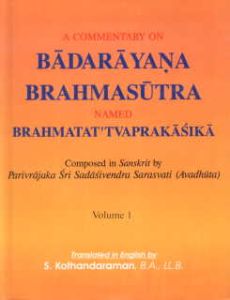
Contents: Vol. I. Picture of Sadasivendra (frontispiece). Key to transliteration. List of abbreviations. Adhikarananukramanika. Introduction. 1. Samanvaya (convergence of meanings). 2. Avirodha (Non-contradiction).
Vol. II. 3. Sadhana (Spiritual practice). 4. Phala (result). 5. Appendices. 6. Alphabetical (Index to sutras) List of aphorisms. 7. General index.
From the introduction: "...West knew very little about the spiritual attainments of the Hindu society, its culture and its well-knit philosophy centuries and centuries before the advent of western civilization. It was during the last three centuries that the cultural heritage of the Hindu society trickled to the western countries in a big way. The Pilgrim Ambassador of India to the Chicago World Religious Congress, Swami Vivekananda's famous lecture about a couple of centuries ago was the beginning of the west taking keen interest in Advaita. Vedanta is not an impractical methodology of self-realization. It is a practical way of realization of the self. During the last century in this country there were, besides others, two outstanding Jivanmuktas who lived several years after realization, radiating knowledge in the true sense of the term and who were introduced world over for the benefit of humanity by westerners themselves. Paul Brunton introduced Ramana Maharsi of Tiruvannamalai in South India in the thirties and Maurice Frydman introduced Nisargadatta Maharaj of Kurla, Mumbai (Bombay) in the seventies of the last century. While Ramana Maharsi has had some education up to elementary standard, Nisargadatta Maharaj had none of that kind. Though they were not so much educated, both were the enlightened soul in the true sense of the term..."
...The central point from which Nisargadatta Maharaj started his advice has always been reverting to the question 'Who am I' just as it was the case with Ramana Maharsi. The quintessence of his teaching is: Give up all questions except one, 'Who am I? After all, the only fact you are sure of is that you are! The 'I am' is certain. The 'I am this' is not. Struggle to find out what you are in reality! To know what you are, you must first investigate and know what you are not.
Discover all that you are not--body, feelings, thought, time, space, this or that--nothing, concrete or abstract, which you perceive can be you. The very act of perceiving shows that you are not what you perceive. The clearer you understand that on the level of mind, you can be described in negative terms only, the quicker will you come to the end of your search and realize that you are the limitless being...."
